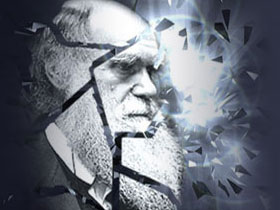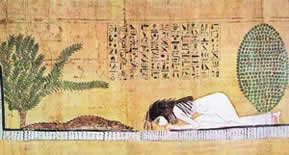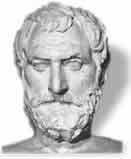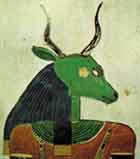In his book, Ancient Views on the Origin of Life, Ernest Abel says that the Greek Miletian philosophers before Socrates drew their concepts of evolution in the context of the creation of the universe from the leaders of even more ancient Egyptian, Babylonian or Sumerian religions… For that reason, he adds, EVOLUTION IS IN NO WAY A MODERN DISCOVERY, but rather a modern form of a world (superstitious) religion that has denied belief in Allah (God) in before the dawn of history… And he goes on to state:
This paper sets out the superstitious beliefs of the pagan religions from which Darwinism stems. Surely Allah is beyond all the beliefs described and all the terms employed in the quotes cited.
Darwinism did not begin with the theory established by the amateur observations and investigations of Charles Darwin and other scientists in the 19th century. Its origins go back to much earlier materialist philosophies. Darwinist beliefs were first encountered a few thousand years ago in the polytheistic and materialistic religions of Greece and Sumeria. One can also encounter the fundamental beliefs of the theory of evolution in various superstitious myths (Hindu, Jain, Inca etc.). For example, beliefs based on unscientific and fictitious myths devoid of any scientific foundation are also to be found in the theory of evolution. These include the ideas that all life emerged spontaneously from water as the supposed result of blind chance, that plants, animals and human beings all share a common ancestor, that human beings are supposedly descended from fish, and that all life forms appeared gradually, over a very long period of time, and quite by chance. Charles Darwin was not, therefore, the originator of the theory of evolution. He was the person who again raised all superstitious, pagan beliefs that had been around for hundreds of years once again in the 19th century, under the name of the theory of evolution.
Darwinism and Superstitious Sumerian Beliefs
The inscriptions of pagan Sumeria, which deny Allah (Allah is beyond that) and assert that living things came to be through an evolutionary process, form the backbone of the religion of Darwinism.ii When Sumerian inscriptions were examined, they revealed a legend stating that first there was a watery chaos and out of that two imaginary gods emerged: Lahmu and Lahamu. iii According to this belief, the two false gods first created themselves, and later as they supposedly evolved, brought other material and living things into existence. In other words, life appeared all at once from the lifeless, watery chaos. The evolutionists' belief that living things first formed from lifeless matter has much in common with the Sumerian belief that the universe developed through an evolutionary process.
Examination of the Enuma Elish iv inscriptions, a fragment of which was discovered in 1849 and which describes the myth of how Babylon was created, reveals different details of the superstitious belief. In these inscriptions we encounter the heretical belief that life began with the alleged fresh water god Apsu and the alleged salt water god Tiamat (Surely Allah is beyond that). v The inscriptions contain the following account: " The primeval sea (abzu) existed before anything else and within that, the heaven (an) and the earth (ki) were formed." vi
Another pagan myth in Sumerian texts concerns the creation of the human race. These texts describe how a supposed god called Prince Ea was given the task of forming a new human race. (Allah is surely beyond this.) The Sumerian texts speak of a process in which Ea altered the genes of an existing apeman or apewoman. As a result of their pagan beliefs, they regarded these as a totally separate species having nothing to do with human beings. vii
Darwinism and Superstitious Egyptian Beliefs
An examination of the history of Egypt reveals the same superstitious beliefs. In one of these ridiculous account bereft of any scientific foundation, we are told that “snakes, frogs, worms and mice came into being from the mud of the River Nile when it burst its banks. " viii
Superstitious Egyptian beliefs speak of a supposed watery chaos ix and of all life emerging spontaneously from it:
"In the beginning there was only water, a chaos of churning, bubbling water. The Egyptians called this Nu or Nun. It was out of Nu that everything began. .. Ra emerged out of primeval chaos, he came out of a blue giant lotus flower that appeared on the surface of the water..." x
Some Egyptian myths speak of a primordial island known as the “island of Creation”:
" The myths all had at the center of their story a primordial mound known as the "Island of Creation.”… The Hermopolitan Myth was developed at Hermopolis. Here the [false] god Thoth, [false] god of wisdom, was the main player. There are several versions to this myth. One account has a group of eight [false] gods all playing major roles in the creation from a primordial ocean.xiv
It is erroneous to think that this concept has now disappeared into the mists of history and perished along with ancient civilizations. Today evolutionists maintain the same idea; they would have the scientific world believe that first there was the sea, the watery chaos, or as they call it, "primeval soup." According to the theory of evolution, four billion years ago some inanimate chemical elements in the primal earth's atmosphere necessary for the development of life, such as carbon and phosphorus, by an operation of chance factors came together in water under the right conditions and in the right proportions. In the meantime there were lightening storms and quakes, and the first building block of life, amino acids, came into being. By the same operation these amino acids became proteins, the proteins formed cells, and through the continuation of this chain of random occurrences, human beings finally came to be...
However, the claim that lifeless matter can coalesce to form life has not been verified in any observation or experiment; it is an extra-scientific claim. One brief example is sufficient to demonstrate the illogicality of this claim: Let Darwinists put plenty of materials present in the composition of living beings such as phosphorus, nitrogen, carbon, oxygen, iron, and magnesium into big barrels. Moreover, let them add in these barrels any material that does not exist under normal conditions, but they think as necessary. Let them add in this mixture as many amino acids-which have no possibility of forming under natural conditions-and as many proteins-a single one of which has a formation probability of 10-950 as they like. Let them expose these mixtures to as much heat and moisture as they like. Let them stir these with whatever technologically developed device they like. Let them put the foremost scientists beside these barrels. Let these experts wait in turn beside these barrels for billions, and even trillions of years. Let them be free to use all kinds of conditions they believe to be necessary for a living thing's formation. No matter what they do, they cannot produce from these barrels a living being, say a professor that examines his cell structure under the electron microscope. They cannot produce giraffes, lions, bees, canaries, horses, dolphins, roses, orchids, lilies, carnations, bananas, oranges, apples, dates, tomatoes, melons, watermelons, figs, olives, grapes, peaches, peafowls, pheasants, multicoloured butterflies, or millions of other living beings such as these. Indeed, they could not obtain even a single cell of any one of them. Briefly, unconscious atoms cannot form the cell by coming together. They cannot take a new decision and divide this cell into two, then take other decisions and form the professors who first invent the electron microscope and then examine their own cell structure under that microscope. Matter comes to life only with Allah's superior creation.
Each living cell is formed by the replication of another cell. No one in the world has ever succeeded in forming a living cell by bringing inanimate materials together, not even in the most advanced laboratories.
Hinduism, which has found masses of adherents for itself in southern Asia with its complex rituals and pagan doctrines, is also founded on the belief that all living things emerged from the oceans. This belief is expounded in detail in the Rig Veda and the Atharva Veda scriptures which illustrate Hindu doctrines with stories of legendary characters. Hinduism rejects the idea of a Creator; according to its philosophy, the whole of the universe evolved out of a huge, glob like mass of material substance, "prakriti." Everything, animate and inanimate, evolved from this primordial substance. At the end of each cosmic period all things are dissolved into their original elements, into prakriti, after which the whole evolutionary process begins again. xv That is, the universe is reformed from this primal lifeless matter.
Pagan Greek Thinkers Sowed the First Seeds of Darwinism
The precursor of Darwinist ideas was presented by Greek Milesian philosophers who had no knowledge of the laws of physics, chemistry or biology. One of the most important assertions of these philosophers, among whom were Thales, Anaximander and Empedocles, was that living things (animals, human beings and plants) were generated spontaneously from inanimate elements such as air, fire and water. This primitive and pagan belief of 2,000 years ago re-emerged as Darwinism in the 19th century.
Thales and the idol of chance
The first of these Milesian philosophers was Thales. He lived in a coastal city and spent a long time in Egypt, where he was influenced by the ancient pagan Egyptian beliefs regarding the creation of life. xvi He became obsessed with the error that living things could generate themselves from water. According to this ignorant idea, first plants, then animals and finally human beings emerged from this water as the work of chance. xvii Thales reached this conclusion by the use of simple logic and inference but with no experiment or scientific observation. Later, other Milesian philosophers established theories on the basis of the same logic.
Anaximander and the nonsense that species evolved from one another
After Thales the most important thinker was his pupil Anaximander, who contributed two important materialist doctrines to the annals of western thought. The first of these is that the universe has always existed and will continue to exist into eternity. The second is an idea that had begun to take shape in the time of Thales: that living things evolved from one another.
Anaximander even wrote a poem called "On Nature," which is the first literary work to contain a theory of evolution. In this poem he wrote that creatures arose from slime that had been dried by the sun. He assumed that the first animals were covered with prickly scales and lived in the seas. xviii As these fish-like creatures evolved, they moved onto land, shed their scaly coverings and eventually became human beings. xix
As we have seen, this interpretation is in complete agreement with Darwin’s theory of evolution, itself devoid of any scientific foundation. In other words, Darwin did not make a new discovery through observation. What he did was to re-instate ancient pagan beliefs. Philosophy text books describe the foundation that Anaximander provided for the theory of evolution.
In his book Ernest Abel says that in the beginning, all entities lived in water. Then with the retraction of the eater and the appearance of pieces of dry land, the entities living in these waters changed in such a way as to live on dry land. This theory may regarded as the first theory of evolution he says, or else as its beginning.xx
We meet an explanation similar to that of Anaximander in Charles Darwin's book The Origin of Species. There is basically no difference between the theory of evolution proposed there (in spite of its pseudo-scientific claims) and the account of the Milesian philosophers who lived in the pagan culture of ancient Greece.
Heraclitus and the natural selection deceit
The thesis that natural selection is due to a struggle for survival among the species is first encountered in the work of the Greek philosopher Heraclitus. According to Heraclitus' thesis, there is a constant struggle among living things. In a sense this is the origin of Darwin's theory of natural selection 2,500 years later.
Empedocles and the human evolution lie
Empedocles (495-435 BC), who lived later than Thales and Anaximander, believed that everything present on the earth came to be through random intermixtures in varying proportions of water, air, fire and earth. The writer David Skjaerlund, who has investigated the philosophical roots of the theory of evolution in his book Philosophical Origins of Evolution, states that Empedocles had some interesting ideas; he "believed that chance alone was responsible for the entire process and that man had developed from prior plant life."xxi The concept of chance in ancient religions forms a basic belief and is also the most important idol of the religion of Darwinism.
Democritus and materialism
Democritus is another Greek philosopher who contributed to the theory of evolution and to those materialist philosophies that take the theory for their foundation. According to Democritus, the universe is composed of small particles called atoms and apart from matter nothing exists. Atoms have always existed - uncreated and indestructible. Hence, matter has always existed and will continue to exist into eternity. Democritus rejected any kind of spiritual faith and claimed that spiritual values, even morality, can be reduced to atoms. Thus, Democritus has been called the first true materialist philosopher; to him the universe has no purpose, everything moves according to a blind necessity, and everything came into being spontaneously by itself. One is reminded again of the false gods of modern evolutionists - unconscious atoms.
Unconscious atoms composing the universe - the world, the air we breathe, what we eat and drink, our bodies - in short, everything we perceive, are central to the Darwinian theory. It is well known that every living thing, human beings included, is made up of atoms of carbon, hydrogen, oxygen, calcium, magnesium, iron and other elements. Darwinism claims that these atoms came together randomly by chance. According to this nonsensical claim, the various atoms that were formed by some unknown impulse later came together incidentally to form stars, planets and all heavenly bodies. After a time atoms again came together by chance to form a living cell with a highly complex structure. Then this living cell underwent a process of evolution to form living things with extraordinarily elaborate systems, and finally, human beings with a highly developed consciousness. Moreover, the human being who is totally the result of chance, with the aid of instruments developed by chance (such as the electron microscope), has discovered the atoms from which he is formed! This is passed off as a scientific thesis!
Thus, the theory of evolution accepts as a fact that every atom is an imaginary god with creative power and intent. But the atoms that form a conscious, intelligent human being are themselves without consciousness or will. Nevertheless, evolutionists claim that these lifeless atoms came together, created a human being, and later this amalgamation of atoms decided to go to college and have a career. However, every experiment and observation has shown that without conscious organization, matter is never able to organize itself; on the contrary, it advances towards disorder and chaos. For this reason it is obvious that nothing in the universe results from chance but has been brought into existence by a being with consciousness and will, knowledge and intelligence. These are attributes of Allah, Lord of the earth and the heavens.
Along with the aforementioned philosophers, another important contributor to the religion of Darwinism was the Greek philosopher Aristotle. According to Aristotle, species can be arranged in a hierarchy from the simplest to the most complex and aligned in a linear form like steps in a ladder; he called this thesis the Scala Naturae. This idea of Aristotle would deeply influence western thought until the 18th century and was later to become the origin of belief in the Great Chain of Being, which, in turn, became the theory of evolution.
Another Belief from Ancient Pagan Cultures: The Great Chain of Being
The underlying idea of Darwinism - that every living thing evolved from matter - is first encountered in the conception of the Great Chain of Being by the Greek philosopher Aristotle. This is an evolutionary belief still popular with those philosophers who deny the existence of Allah
The originally Greek idea that the first living thing spontaneously produced itself from water in the course of time became the doctrine of the Great Chain of Being. According to the Scala Naturae which had been accepted for 2000 years, living things formed by themselves evolving from minerals to organic matter, from living organisms to plants, animals, human beings and finally to so-called "gods." (Allah is beyond that) According to this belief, new organs formed by themselves conforming to the needs of nature.
According to this specious reasoning, small living things became larger living things stage by stage; every living thing has its place in the chain. It asserts also that stone, metal, water and air became living organisms, living organisms became animals, and animals became human beings without any interruption in the process. The reason this belief (which has no scientific foundation, contradicts all scientific facts, and stands only on abstract logic) has won acceptance for so long is not a scientific but an ideological one. What allows this false belief to endure is a dogmatic approach that denies the existence of Allah. This belief periodically changed its name, was elaborated, and finally became known as the "theory of evolution."
But it must be repeated: the alleged serial arrangement takes no account of science. There is no consideration of the physical characteristics of living things or about how life could come into being from lifeless materials or how water-dwelling creatures could adapt to life on land. Transitional forms, which are supposed to represent links of development between species constitute one of the most serious impasses in the theory of evolution today because they are not found in the fossil record. How creatures change into others remains a great mystery because the chain is merely the product of a superficial abstract logic invented by ancient philosophers around a table.
The reason this belief (which has no scientific foundation, contradicts all scientific facts, and stands only on abstract logic) has won acceptance for so long is not a scientific but an ideological one. What allows this false belief to endure is a dogmatic approach that denies the existence of Allah. This belief periodically changed its name, was elaborated, and finally became known as the "theory of evolution."
The period in which the Scala Naturae came into western thought coincides with advent of humanism and the Renaissance. At the beginning of the 15th century Greek and Latin works were brought into Europe and entered the current of western thought and philosophy. Foremost in these texts was the concept of materialism and denial of the existence of a Creator.(Allah is beyond that) the Great Chain of Being formed the basis of this belief by stating that human beings had come into being by chance as a result of an evolutionary process and were essentially nothing more than a lump of matter. Thus, moral values and human feelings have no importance; a person should simply enjoy each day he lives and feel responsible to no one. In time, Aristotle's concept of divinity at the top of the Scala Naturae was replaced by the humanist idea of man as the highest being. (Allah is beyond that) There is no doubt that this is an idea that inflicted terrible physical and spiritual damage on the Western world. People who saw themselves as being a collection of matter regarded ruthlessness, selfishness and cruelty and justified in their own eyes, and thus inflicted a troubled, dark life on themselves and others. Human beings are not the work of unconscious atoms and blind chance. Allah created human beings, the universe they live in and all living things, and everyone has a responsibility to Him.
There is a strong parallel between the theory of evolution, which represents the basis of materialist and atheist philosophies, and the Scala naturae and Great Chain of Being that form the vital source of ancient pagan materialist philosophies. Today, materialism draws strength through the theory of evolution, as in the past, materialist thinking was based on the Great Chain of Being.
The Great Chain of Being was quite popular from the Renaissance until the 18th century and exerted much influence on the materialist scientists of that era. French scientists Benoit de Maillet, Pierre de Maupertuis, Comte de Buffon and Jean Baptiste Lamarck, among others, who had a strong influence on Charles Darwin, were men who had appropriated the Greek notion of the Great Chain of Being. They based their scientific research on this evolutionist view. The common tenet of these men was that the various living species were not created individually but came into existence spontaneously through a process of evolution dependent on natural conditions a model similar to Darwin's.(Allah is beyond that) For this reason it can be said that modern evolutionary thought was born in France.
The French evolutionist Comte de Buffon was one of the most well-known scientists of the 18th century. For more than fifty years he was the director of the Royal Botanical Gardens in Paris. Darwin based much of his theory on his works. In his 44-volume work Histoire Naturelle, it is possible to find most of the elements that Darwin was to use.
The Great Chain of Being was the base of the evolutionist systems of both de Buffon and Lamarck. The American historian of science, D.R. Oldroyd, defines their relationship in these words:
As one can clearly see, what is called the "theory of evolution" is really a transferal to modern times of the ancient Greek myth of the Great Chain of Being. There were evolutionists before Darwin, and most of their ideas and so-called proofs were already found in the concept of the Great Chain of Being. With de Buffon and Lamarck, the Great Chain was offered to the scientific world in a new form which influenced Darwin.
Indeed, Darwin was influenced by this idea to the extent that he based his whole theory on its basic logic. In the book Darwin's Century, Loren Eiseley points out that Darwin made use of the 18th century concept of the scale of existence in his book The Origin of Species and that the idea that whole organic matter tended inevitably to "progress toward perfection" finds its origin there.xxiii
Therefore, Darwin did not propose a new theory. What he did was nothing more than to give it new expression in contemporary scientific language. Based on a few deceptive observations, a religion going back to the pagan myths of the Sumerians and ancient Greeks was sustained. It was enhanced in the 17th and 18th centuries with new additions by many scientists. Later, through Darwin's book The Origin of Species, the theory gained a scientific veneer to become the greatest falsehood in the history of science.
The superstitious origins of Darwinism
One of the greatest impasses in the religion of Darwinism is the question of how living things first came into being. Evolutionists generally prefer to avoid this question because the most concrete answer they can give is no different from that given by religions of centuries ago. During the period in which Darwinism developed, false beliefs about the formation of living things were already prevalent; flies came from sweat, frogs from mud, and ants from sugar.
One of these nonsensical beliefs is that of the "hopeful monster" - the strangest theory in the history of evolution. Due to the fact that the hoped-for transitional fossil forms had not been found, some evolutionists were under a good deal of pressure. So they decided that there was no need for transitional forms because the transition from one species to another had happened suddenly. Consequently, they proposed the theory of the hopeful monster. According to this theory, the formation of living things is no different from the claim that ants came from sugar. The first bird emerged suddenly from a reptile egg; later, in the same way, another bird came by chance from another egg. These two birds came together, and a bird family formed. A similar theory, proposed by Charles Darwin, is that bears who spent much time in water changed into whales in the course of time. However, today's scientific facts clearly demonstrate how unscientific and deceptive is this claim. (For detailed information on these subjects see The Evolution Deceit and Darwinism Refuted, by Harun Yahya.)
Modern evolutionists still blindly believe that an illusory god called Mother Nature created them, showing the same ignorance as the ancient Greeks and Sumerians who worshipped imaginary gods created in their own minds. In order to understand just how inept false religions are, it is only necessary to look around, for everything in its smallest detail displays beauty, sublime artistry and design. It takes only common sense to perceive that this flawless precision could not have come into being by blind chance through powerless deities or a natural chain beginning with primeval soup and a stroke of lightening. The disbelieving mind-bent of those who do not believe in Allah is described in the Qur'an:
As described in these verses, people who continue to deny the existence of Allah live in complete ignorance. They will accept every kind of falsehood but remain stubborn when it comes to the truth. They prefer not to believe in logical scientific facts but in illusions which their lower selves have made pleasing to them. Belief in evolution from earliest times has been the result of a disbelieving mind-set. Moreover, this mentality will always exist, for it is part of Allah's decree. The Qur'an confirms this fact:
There will always be people with an denier mindset, of course. But Allah will always bestow success and victory on believers. This is the law and promise of Allah, and the huge intellectual defeat suffered by Darwinism in the present century is plain to see. The nonsensical ideas of the religion of Darwinism have been exposed, people have seen the truth, and we are now at the stage where the theory of evolution is being consigned to the wastes of history. Darwinists’ final death throes will not alter that fact. As our Lord says in verse 81 of Surat al-Isra’:
___________________________________________________________
i Abel, Ernest L., Ancient Views on the Origin of Life, Farleigh: Dickinson University Press, 1973, p.15
ii Dr. Kenneth Cumming, "The Collapse of the Theory of Evolution, the Fact of Creation," conference speech, April 4, 1998
iii http://history-world.org/cosmogony_and_cosmology.htm
iv http://dmc.utep.edu/westch/reading/epic.html
v http://www.crystalinks.com/enumaelish.html
vi K Kramer, Samuel Noah, Sumerian Mythology, Harper & Brothers, New York, 1961. pp. 112-113; Sumerian Mythology FAQ 1.9 http://www.ping.de/sites/systemcoder/necro/info/sumerfaq.htm
vii http://www.theforbiddenknowledge.com/genesis/
viii Osman Gürel, Yaşamın Kökeni, Pan Yayıncılık, Ekim 1999, s. 4
ix http://buglady.clc.uc.edu/biology/bio106/earlymod.htm
x http://www.aldokkan.com/religion/creation.htm
xi http://www.theforbiddenknowledge.com/genesis/
xii Osman Gürel, Yaşamın Kökeni, Pan Yayıncılık, Ekim 1999, s. 4
xiii http://buglady.clc.uc.edu/biology/bio106/earlymod.htm
xiv http://www.aldokkan.com/religion/creation.htm
xv http://historylink101.net/egypt_1/religion_creation_myths.htm
xvi A Reasoned Look at Asian Religions, pp. 87-88; World's Religions, p. 108
xvii Ernest L. Abel, Ancient Views on the Origin of Life, Farleigh; Dickinson University Press, 1973, p. 19
xvii Philosophical Origins of Evolution, Aralık 2007, http://www.forerunner.com/forerunner/X0742_Philosophical_origin.html
xviii Philosophical Origins of Evolution, Aralık 2007, http://www.forerunner.com/forerunner/X0742_Philosophical_origin.html
xiv http://biology.clc.uc.edu/courses/ bio106/earlymod.htm
xx Ernest L. Abel, Ancient Views on the Origin of Life, Farleigh; Dickinson University Press, 1973, p. 24-25
xxi www.forerunner.com/forerunner/ X0742_Philosophical_origin.html
xxii Darwinian Impacts, p. 23 and p. 32
xxii Loren Eiseley, Darwin's Century, p. 283
“Although it is customary to credit the inception of this theory to Charles Darwin and his immediate predecessors, a rudimentary form of this notion can be traced back to the beginnings of written history itself.” i
This paper sets out the superstitious beliefs of the pagan religions from which Darwinism stems. Surely Allah is beyond all the beliefs described and all the terms employed in the quotes cited.
Darwinism did not begin with the theory established by the amateur observations and investigations of Charles Darwin and other scientists in the 19th century. Its origins go back to much earlier materialist philosophies. Darwinist beliefs were first encountered a few thousand years ago in the polytheistic and materialistic religions of Greece and Sumeria. One can also encounter the fundamental beliefs of the theory of evolution in various superstitious myths (Hindu, Jain, Inca etc.). For example, beliefs based on unscientific and fictitious myths devoid of any scientific foundation are also to be found in the theory of evolution. These include the ideas that all life emerged spontaneously from water as the supposed result of blind chance, that plants, animals and human beings all share a common ancestor, that human beings are supposedly descended from fish, and that all life forms appeared gradually, over a very long period of time, and quite by chance. Charles Darwin was not, therefore, the originator of the theory of evolution. He was the person who again raised all superstitious, pagan beliefs that had been around for hundreds of years once again in the 19th century, under the name of the theory of evolution.
Darwinism and Superstitious Sumerian Beliefs
The inscriptions of pagan Sumeria, which deny Allah (Allah is beyond that) and assert that living things came to be through an evolutionary process, form the backbone of the religion of Darwinism.ii When Sumerian inscriptions were examined, they revealed a legend stating that first there was a watery chaos and out of that two imaginary gods emerged: Lahmu and Lahamu. iii According to this belief, the two false gods first created themselves, and later as they supposedly evolved, brought other material and living things into existence. In other words, life appeared all at once from the lifeless, watery chaos. The evolutionists' belief that living things first formed from lifeless matter has much in common with the Sumerian belief that the universe developed through an evolutionary process.
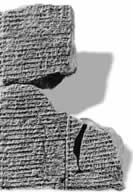 | 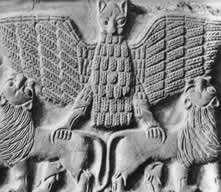 | 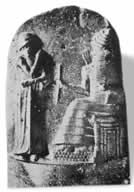 |
| From the earliest ages there have been pagan peoples. In every era human beings have made idols for themselves. In the same way that Darwinists accept coincidence and lifeless matter as idols with creative power, in earlier societies with a misguided belief, similar things were worshipped as idols. Top and bottom left: Representations of the Sumerian’s false water gods. Top right: Hammurabi praying before the Mesopotamian’s false sun god. Bottom right: A Sumerian tablet describing the stages, according to their superstitious belief, in the creation of human beings upon the order of the false water god. |
Examination of the Enuma Elish iv inscriptions, a fragment of which was discovered in 1849 and which describes the myth of how Babylon was created, reveals different details of the superstitious belief. In these inscriptions we encounter the heretical belief that life began with the alleged fresh water god Apsu and the alleged salt water god Tiamat (Surely Allah is beyond that). v The inscriptions contain the following account: " The primeval sea (abzu) existed before anything else and within that, the heaven (an) and the earth (ki) were formed." vi
Another pagan myth in Sumerian texts concerns the creation of the human race. These texts describe how a supposed god called Prince Ea was given the task of forming a new human race. (Allah is surely beyond this.) The Sumerian texts speak of a process in which Ea altered the genes of an existing apeman or apewoman. As a result of their pagan beliefs, they regarded these as a totally separate species having nothing to do with human beings. vii
Darwinism and Superstitious Egyptian Beliefs
An examination of the history of Egypt reveals the same superstitious beliefs. In one of these ridiculous account bereft of any scientific foundation, we are told that “snakes, frogs, worms and mice came into being from the mud of the River Nile when it burst its banks. " viii
Superstitious Egyptian beliefs speak of a supposed watery chaos ix and of all life emerging spontaneously from it:
"In the beginning there was only water, a chaos of churning, bubbling water. The Egyptians called this Nu or Nun. It was out of Nu that everything began. .. Ra emerged out of primeval chaos, he came out of a blue giant lotus flower that appeared on the surface of the water..." x
• "In ancient Egypt it was believed that under the conditions of the primeval world, their [false] god called Ra emerged from a blue lotus as a result of interactions between the forces of water, air, darkness and infinity." xi
• "The Egyptians believed that the universe was initially filled with the dark waters of chaos. The first [false] god, Ra-Atum, rose up and emerged from the waters of the River Nile that burst its banks and flooded the land of Egypt every year.” xii
• It comes as no surprise that water is a fundamental element in Egyptian creation myths. Because the Nile was of vital importance to the Egyptians... According to Egyptian myths, “a chaos of churning, bubbling water. The Egyptians called this Nu or Nun. It was out of Nu that everything began. … the Nile river, with its annual floods played a critical role in this cosmic order…. xiii
Some Egyptian myths speak of a primordial island known as the “island of Creation”:
" The myths all had at the center of their story a primordial mound known as the "Island of Creation.”… The Hermopolitan Myth was developed at Hermopolis. Here the [false] god Thoth, [false] god of wisdom, was the main player. There are several versions to this myth. One account has a group of eight [false] gods all playing major roles in the creation from a primordial ocean.xiv
It is erroneous to think that this concept has now disappeared into the mists of history and perished along with ancient civilizations. Today evolutionists maintain the same idea; they would have the scientific world believe that first there was the sea, the watery chaos, or as they call it, "primeval soup." According to the theory of evolution, four billion years ago some inanimate chemical elements in the primal earth's atmosphere necessary for the development of life, such as carbon and phosphorus, by an operation of chance factors came together in water under the right conditions and in the right proportions. In the meantime there were lightening storms and quakes, and the first building block of life, amino acids, came into being. By the same operation these amino acids became proteins, the proteins formed cells, and through the continuation of this chain of random occurrences, human beings finally came to be...
However, the claim that lifeless matter can coalesce to form life has not been verified in any observation or experiment; it is an extra-scientific claim. One brief example is sufficient to demonstrate the illogicality of this claim: Let Darwinists put plenty of materials present in the composition of living beings such as phosphorus, nitrogen, carbon, oxygen, iron, and magnesium into big barrels. Moreover, let them add in these barrels any material that does not exist under normal conditions, but they think as necessary. Let them add in this mixture as many amino acids-which have no possibility of forming under natural conditions-and as many proteins-a single one of which has a formation probability of 10-950 as they like. Let them expose these mixtures to as much heat and moisture as they like. Let them stir these with whatever technologically developed device they like. Let them put the foremost scientists beside these barrels. Let these experts wait in turn beside these barrels for billions, and even trillions of years. Let them be free to use all kinds of conditions they believe to be necessary for a living thing's formation. No matter what they do, they cannot produce from these barrels a living being, say a professor that examines his cell structure under the electron microscope. They cannot produce giraffes, lions, bees, canaries, horses, dolphins, roses, orchids, lilies, carnations, bananas, oranges, apples, dates, tomatoes, melons, watermelons, figs, olives, grapes, peaches, peafowls, pheasants, multicoloured butterflies, or millions of other living beings such as these. Indeed, they could not obtain even a single cell of any one of them. Briefly, unconscious atoms cannot form the cell by coming together. They cannot take a new decision and divide this cell into two, then take other decisions and form the professors who first invent the electron microscope and then examine their own cell structure under that microscope. Matter comes to life only with Allah's superior creation.
Each living cell is formed by the replication of another cell. No one in the world has ever succeeded in forming a living cell by bringing inanimate materials together, not even in the most advanced laboratories.
SOME INSCRIPTIONS DEPICTING THESE HERETICAL BELIEFS
| The Error That Life Emerged by Chance from Water |
 |
| Ea stands in his watery home the Apsu |
| The Passage from Water to Land Lie |
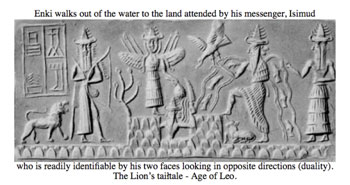 |
| Depiction of the deity Enki’s passage from water to dry land |
| The Pagan Origin of the Darwinist Tree of Life |
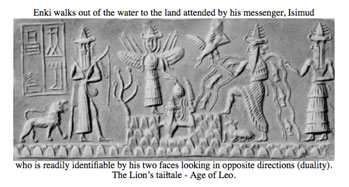 |
| Sumerian tablet describing the stages, according to their superstitious belief, in the creation of human beings upon the order of the false water god. |
Darwinism and Hinduism
Hinduism, which has found masses of adherents for itself in southern Asia with its complex rituals and pagan doctrines, is also founded on the belief that all living things emerged from the oceans. This belief is expounded in detail in the Rig Veda and the Atharva Veda scriptures which illustrate Hindu doctrines with stories of legendary characters. Hinduism rejects the idea of a Creator; according to its philosophy, the whole of the universe evolved out of a huge, glob like mass of material substance, "prakriti." Everything, animate and inanimate, evolved from this primordial substance. At the end of each cosmic period all things are dissolved into their original elements, into prakriti, after which the whole evolutionary process begins again. xv That is, the universe is reformed from this primal lifeless matter.
In the picture above a human being worships a crocodile. As in the past, some societies today worship animals such as crocodiles, cows or lifeless things such as water or fire, believing that they supposedly are gods with creative power. There is nothing in this belief compatible with reason, logic or conscience. It is clear that a crocodile is too weak in mind to have any power or wisdom. However, Darwinists espouse a similar belief. For them it is not crocodiles or fire that has creative power but unconscious atoms and coincidences. They adhere to this belief as to a religion. |
The precursor of Darwinist ideas was presented by Greek Milesian philosophers who had no knowledge of the laws of physics, chemistry or biology. One of the most important assertions of these philosophers, among whom were Thales, Anaximander and Empedocles, was that living things (animals, human beings and plants) were generated spontaneously from inanimate elements such as air, fire and water. This primitive and pagan belief of 2,000 years ago re-emerged as Darwinism in the 19th century.
Thales and the idol of chance
The first of these Milesian philosophers was Thales. He lived in a coastal city and spent a long time in Egypt, where he was influenced by the ancient pagan Egyptian beliefs regarding the creation of life. xvi He became obsessed with the error that living things could generate themselves from water. According to this ignorant idea, first plants, then animals and finally human beings emerged from this water as the work of chance. xvii Thales reached this conclusion by the use of simple logic and inference but with no experiment or scientific observation. Later, other Milesian philosophers established theories on the basis of the same logic.
Right: The imaginary god that Egyptians believed protected the Nile. |
Anaximander and the nonsense that species evolved from one another
After Thales the most important thinker was his pupil Anaximander, who contributed two important materialist doctrines to the annals of western thought. The first of these is that the universe has always existed and will continue to exist into eternity. The second is an idea that had begun to take shape in the time of Thales: that living things evolved from one another.
Anaximander even wrote a poem called "On Nature," which is the first literary work to contain a theory of evolution. In this poem he wrote that creatures arose from slime that had been dried by the sun. He assumed that the first animals were covered with prickly scales and lived in the seas. xviii As these fish-like creatures evolved, they moved onto land, shed their scaly coverings and eventually became human beings. xix
As we have seen, this interpretation is in complete agreement with Darwin’s theory of evolution, itself devoid of any scientific foundation. In other words, Darwin did not make a new discovery through observation. What he did was to re-instate ancient pagan beliefs. Philosophy text books describe the foundation that Anaximander provided for the theory of evolution.
In his book Ernest Abel says that in the beginning, all entities lived in water. Then with the retraction of the eater and the appearance of pieces of dry land, the entities living in these waters changed in such a way as to live on dry land. This theory may regarded as the first theory of evolution he says, or else as its beginning.xx
We meet an explanation similar to that of Anaximander in Charles Darwin's book The Origin of Species. There is basically no difference between the theory of evolution proposed there (in spite of its pseudo-scientific claims) and the account of the Milesian philosophers who lived in the pagan culture of ancient Greece.
Heraclitus and the natural selection deceit
The thesis that natural selection is due to a struggle for survival among the species is first encountered in the work of the Greek philosopher Heraclitus. According to Heraclitus' thesis, there is a constant struggle among living things. In a sense this is the origin of Darwin's theory of natural selection 2,500 years later.
Empedocles and the human evolution lie
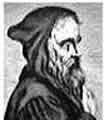 Empedocles |
Democritus and materialism
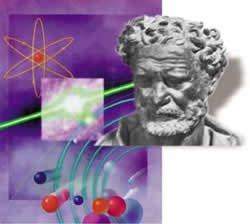 Democritus, like modern-day materialists, believed erroneously that matter is eternal and that nothing exists but matter. |
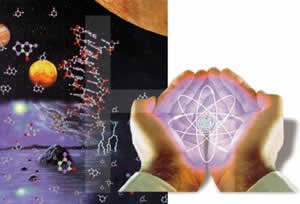 Evolutionists claim that atoms came into being as a result of chance and gave rise to the whole universe. That is, that one group of unconscious atoms formed the stars, the planets and the earth; another group formed living things. Then, another group of unconscious atoms formed the eye, the heart, the nervous system, the brain and the whole perfect anatomical system of a human being. Later, this human became a professor and started to investigate the atoms that created him. It is obvious that such a claim is unconvincing and far removed from intelligent scientific methods. The whole universe and every living thing in it was perfectly created with the sublime knowledge of Allah. |
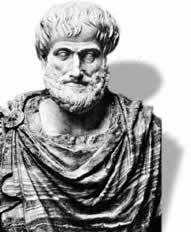 The Greek philosopher Aristotle: His thesis, Scala Naturae, was a source of inspiration for modern evolutionists. |
Along with the aforementioned philosophers, another important contributor to the religion of Darwinism was the Greek philosopher Aristotle. According to Aristotle, species can be arranged in a hierarchy from the simplest to the most complex and aligned in a linear form like steps in a ladder; he called this thesis the Scala Naturae. This idea of Aristotle would deeply influence western thought until the 18th century and was later to become the origin of belief in the Great Chain of Being, which, in turn, became the theory of evolution.
Another Belief from Ancient Pagan Cultures: The Great Chain of Being
The underlying idea of Darwinism - that every living thing evolved from matter - is first encountered in the conception of the Great Chain of Being by the Greek philosopher Aristotle. This is an evolutionary belief still popular with those philosophers who deny the existence of Allah
The originally Greek idea that the first living thing spontaneously produced itself from water in the course of time became the doctrine of the Great Chain of Being. According to the Scala Naturae which had been accepted for 2000 years, living things formed by themselves evolving from minerals to organic matter, from living organisms to plants, animals, human beings and finally to so-called "gods." (Allah is beyond that) According to this belief, new organs formed by themselves conforming to the needs of nature.
According to this specious reasoning, small living things became larger living things stage by stage; every living thing has its place in the chain. It asserts also that stone, metal, water and air became living organisms, living organisms became animals, and animals became human beings without any interruption in the process. The reason this belief (which has no scientific foundation, contradicts all scientific facts, and stands only on abstract logic) has won acceptance for so long is not a scientific but an ideological one. What allows this false belief to endure is a dogmatic approach that denies the existence of Allah. This belief periodically changed its name, was elaborated, and finally became known as the "theory of evolution."
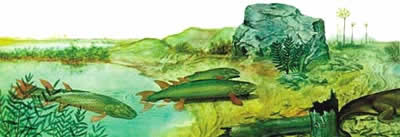 A picture illustrating the evolutionist story of the supposed transition from water to land. 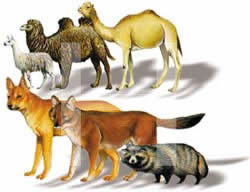 According to the idea of the Great Chain of Being, which goes back to Aristotle, living things evolved from the smallest creatures to larger ones. However, modern science has shown that this claim is invalid; that the similarities among living things is not proof of evolution; that the creatures illustrated in the picture did not evolve from other creatures but every one was created in its present form. |
But it must be repeated: the alleged serial arrangement takes no account of science. There is no consideration of the physical characteristics of living things or about how life could come into being from lifeless materials or how water-dwelling creatures could adapt to life on land. Transitional forms, which are supposed to represent links of development between species constitute one of the most serious impasses in the theory of evolution today because they are not found in the fossil record. How creatures change into others remains a great mystery because the chain is merely the product of a superficial abstract logic invented by ancient philosophers around a table.
The reason this belief (which has no scientific foundation, contradicts all scientific facts, and stands only on abstract logic) has won acceptance for so long is not a scientific but an ideological one. What allows this false belief to endure is a dogmatic approach that denies the existence of Allah. This belief periodically changed its name, was elaborated, and finally became known as the "theory of evolution."
 Pierre de Maupertuis |
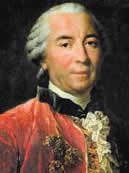 De Buffon and his 44-volume work Histoire Naturelle, which takes its inspiration from ancient pagan mythology. |
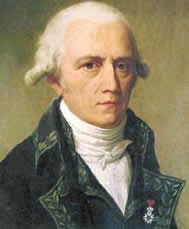 Jean Baptiste Lamarck |
The French evolutionist Comte de Buffon was one of the most well-known scientists of the 18th century. For more than fifty years he was the director of the Royal Botanical Gardens in Paris. Darwin based much of his theory on his works. In his 44-volume work Histoire Naturelle, it is possible to find most of the elements that Darwin was to use.
The Great Chain of Being was the base of the evolutionist systems of both de Buffon and Lamarck. The American historian of science, D.R. Oldroyd, defines their relationship in these words:
In his Histoire Naturelle, Buffon reveals himself as an exponent of the doctrine of the Great Chain of Being, with man being placed at the top of the Chain... Lamarck held a version of the ancient doctrine of the Great Chain of Being. Yet, ...it was not conceived as a rigid, static structure. By their struggle to meet the requirements of the environment, and with the help of the principle of the inheritance of acquired characteristics, organisms could supposedly work their way up the Chain - from microbe to man, so to speak... Moreover, new creatures were constantly appearing at the bottom of the Chain, arising from inorganic matter through spontaneous generation... Ascent of the Chain involved a continuous process of complexification, due to the so-called "power of life." xxii
 Loren Eiseley |
Indeed, Darwin was influenced by this idea to the extent that he based his whole theory on its basic logic. In the book Darwin's Century, Loren Eiseley points out that Darwin made use of the 18th century concept of the scale of existence in his book The Origin of Species and that the idea that whole organic matter tended inevitably to "progress toward perfection" finds its origin there.xxiii
Therefore, Darwin did not propose a new theory. What he did was nothing more than to give it new expression in contemporary scientific language. Based on a few deceptive observations, a religion going back to the pagan myths of the Sumerians and ancient Greeks was sustained. It was enhanced in the 17th and 18th centuries with new additions by many scientists. Later, through Darwin's book The Origin of Species, the theory gained a scientific veneer to become the greatest falsehood in the history of science.
The superstitious origins of Darwinism
One of the greatest impasses in the religion of Darwinism is the question of how living things first came into being. Evolutionists generally prefer to avoid this question because the most concrete answer they can give is no different from that given by religions of centuries ago. During the period in which Darwinism developed, false beliefs about the formation of living things were already prevalent; flies came from sweat, frogs from mud, and ants from sugar.
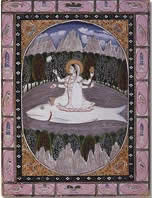 The Hindu’s false river goddess |
Modern evolutionists still blindly believe that an illusory god called Mother Nature created them, showing the same ignorance as the ancient Greeks and Sumerians who worshipped imaginary gods created in their own minds. In order to understand just how inept false religions are, it is only necessary to look around, for everything in its smallest detail displays beauty, sublime artistry and design. It takes only common sense to perceive that this flawless precision could not have come into being by blind chance through powerless deities or a natural chain beginning with primeval soup and a stroke of lightening. The disbelieving mind-bent of those who do not believe in Allah is described in the Qur'an:
"And they said, No matter what sign you bring us with which to bewitch us, we will not be believers for you." (Surat al-Araf, 132)
"And even if We had sent down to them the angels and the dead spoke to them and We gathered together every [created] thing in front of them, they would not believe unless Allah should will. most of them, [of that], are ignorant." (Surat al-An'am, 111)
"And even if We opened to them a gate from the heaven and they continued therein to ascend, they would say, Our eyes have only been dazzled; rather, we are a people affected by magic." (Surat al-Hijr,14-15)
As described in these verses, people who continue to deny the existence of Allah live in complete ignorance. They will accept every kind of falsehood but remain stubborn when it comes to the truth. They prefer not to believe in logical scientific facts but in illusions which their lower selves have made pleasing to them. Belief in evolution from earliest times has been the result of a disbelieving mind-set. Moreover, this mentality will always exist, for it is part of Allah's decree. The Qur'an confirms this fact:
"And We have certainly created for Hell many of the jinn and mankind. They have hearts with which they do not understand, they have eyes with which they do not see, and they have ears with which they do not hear. Those are like livestock; rather, they are more astray. It is those who are the heedless." (Surat al-Araf, 179)
There will always be people with an denier mindset, of course. But Allah will always bestow success and victory on believers. This is the law and promise of Allah, and the huge intellectual defeat suffered by Darwinism in the present century is plain to see. The nonsensical ideas of the religion of Darwinism have been exposed, people have seen the truth, and we are now at the stage where the theory of evolution is being consigned to the wastes of history. Darwinists’ final death throes will not alter that fact. As our Lord says in verse 81 of Surat al-Isra’:
"Truth has come and falsehood has vanished."
___________________________________________________________
i Abel, Ernest L., Ancient Views on the Origin of Life, Farleigh: Dickinson University Press, 1973, p.15
ii Dr. Kenneth Cumming, "The Collapse of the Theory of Evolution, the Fact of Creation," conference speech, April 4, 1998
iii http://history-world.org/cosmogony_and_cosmology.htm
iv http://dmc.utep.edu/westch/reading/epic.html
v http://www.crystalinks.com/enumaelish.html
vi K Kramer, Samuel Noah, Sumerian Mythology, Harper & Brothers, New York, 1961. pp. 112-113; Sumerian Mythology FAQ 1.9 http://www.ping.de/sites/systemcoder/necro/info/sumerfaq.htm
vii http://www.theforbiddenknowledge.com/genesis/
viii Osman Gürel, Yaşamın Kökeni, Pan Yayıncılık, Ekim 1999, s. 4
ix http://buglady.clc.uc.edu/biology/bio106/earlymod.htm
x http://www.aldokkan.com/religion/creation.htm
xi http://www.theforbiddenknowledge.com/genesis/
xii Osman Gürel, Yaşamın Kökeni, Pan Yayıncılık, Ekim 1999, s. 4
xiii http://buglady.clc.uc.edu/biology/bio106/earlymod.htm
xiv http://www.aldokkan.com/religion/creation.htm
xv http://historylink101.net/egypt_1/religion_creation_myths.htm
xvi A Reasoned Look at Asian Religions, pp. 87-88; World's Religions, p. 108
xvii Ernest L. Abel, Ancient Views on the Origin of Life, Farleigh; Dickinson University Press, 1973, p. 19
xvii Philosophical Origins of Evolution, Aralık 2007, http://www.forerunner.com/forerunner/X0742_Philosophical_origin.html
xviii Philosophical Origins of Evolution, Aralık 2007, http://www.forerunner.com/forerunner/X0742_Philosophical_origin.html
xiv http://biology.clc.uc.edu/courses/ bio106/earlymod.htm
xx Ernest L. Abel, Ancient Views on the Origin of Life, Farleigh; Dickinson University Press, 1973, p. 24-25
xxi www.forerunner.com/forerunner/ X0742_Philosophical_origin.html
xxii Darwinian Impacts, p. 23 and p. 32
xxii Loren Eiseley, Darwin's Century, p. 283

